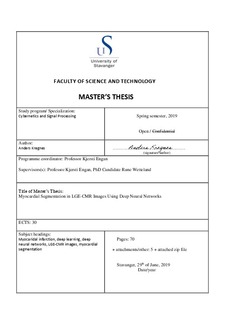| dc.contributor.advisor | Engan, Kjersti | |
| dc.contributor.advisor | Wetteland, Rune | |
| dc.contributor.author | Kregnes, Anders | |
| dc.date.accessioned | 2019-10-04T11:40:05Z | |
| dc.date.available | 2019-10-04T11:40:05Z | |
| dc.date.issued | 2019-07-29 | |
| dc.identifier.uri | http://hdl.handle.net/11250/2620335 | |
| dc.description | Master's thesis in Automation and signal processing | nb_NO |
| dc.description.abstract | Cardiovascular diseases are the number one cause of death globally. 85% of these deaths are related to acute myocardial infarction or stroke. One of the methods that are used to diagnose patients affected by myocardial infarction is myocardial segmentation in Late Gadolinium-Enhancement Cardiac Magnetic Resonance (LGE-CMR) images. The myocardial segmentation is today performed by an experienced cardiologist, manually or semi-automatically. The work is difficult and timeconsuming, due to indistinct boundaries and variable pixel intensities. The primary objective of this thesis was to develop a method for automatic segmentation of the myocardium, using deep neural networks, to aid the cardiologists. The proposed method uses the architecture of a Fully Convolutional Network. The network is trained on images and masks given by The Department of Cardiology at Stavanger University Hospital. Two experimental layouts have been used; binary- and multiclass segmentation. In the binary experiments, masks consisting of two classes were used; the background and the myocardium. In the multiclass experiment, masks were divided into three classes; the background,healthy myocardium and myocardial scartissue. The network was trained on 2006 images with corresponding masks, with the best model tested on 244 images from 30 patients. The predicted masks were compared to masks made by cardiologists at Stavanger University Hospital to evaluate the performance of the models. The bestdeveloped model gave a Dice coefficient score of 0.705 With a standard deviation of 0.15. Considering the observations in this thesis, there is assumed further development of deep neural networks can improve the performance of myocardial segmentation. | nb_NO |
| dc.language.iso | eng | nb_NO |
| dc.publisher | University of Stavanger, Norway | nb_NO |
| dc.relation.ispartofseries | Masteroppgave/UIS-TN-IDE/2019; | |
| dc.rights | Navngivelse 4.0 Internasjonal | * |
| dc.rights.uri | http://creativecommons.org/licenses/by/4.0/deed.no | * |
| dc.subject | kybernetikk and signalbehandling | nb_NO |
| dc.subject | automatisering | nb_NO |
| dc.subject | informasjonsteknologi | nb_NO |
| dc.subject | hjerte- og karsykdommer | nb_NO |
| dc.subject | neural networks | nb_NO |
| dc.title | Myocardial Segmentation in LGE-CMR Images Using Deep Neural Networks | nb_NO |
| dc.type | Master thesis | nb_NO |
| dc.subject.nsi | VDP::Technology: 500::Information and communication technology: 550 | nb_NO |

